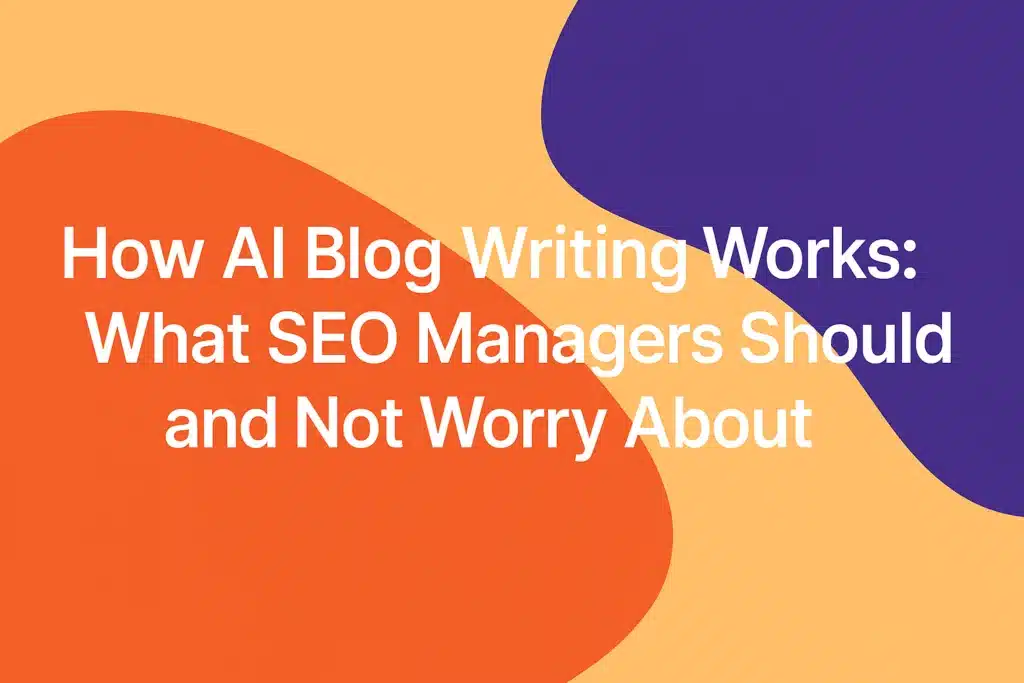SEO managers often look for quick methods to create engaging blog posts. AI blog writing offers a fast path to creating content without losing clarity or nuance. This summary shows how AI helps with research and first drafts. It explains what teams should watch for when using automatic tools. Readers can also see how to keep brand voice strong and follow search engine rules.
Role of AI in blog writing versus human input
AI blog writing uses language models to produce initial drafts and outlines with remarkable speed. Yet human input remains essential for adding a personal tone, addressing topics in depth, and including humor. AI is skilled at handling large sets of data and spotting patterns, while human editors add relevant examples and real-life proof. This mix creates balanced content that addresses both search engine standards and the audience’s needs. AI truly is best at handling repeated or data-heavy tasks, leaving writers free to focus on new ideas and strategy. Through this shared approach, AI and humans build content that stands out, connects with readers, and serves broader business goals. AI also suggests fresh angles to create unique ideas.
How SEO Managers Can Use AI Generated Content for Blogs
SEO managers often use AI generated content to speed up their production timelines. Smart AI-driven tools handle duties like keyword finding and outline building, which lowers manual effort and shortens overall writing cycles. Once the draft is ready, managers can improve it to match brand tone. AI suggestions usually save time on brainstorming and straightforward edits, leaving space for deeper study and creative twists. However, teams still keep control of the final copy, making sure the content stays personal and meets search engine needs. This balance helps SEO managers meet deadlines and build multiple pieces of content that draw traffic. Human input also limits overly generic text and preserves a sense of realness.
Finding when to use AI generated content for blogs
Teams often use AI generated content for blogs when they need quick posts or when covering routine topics. Google’s position suggests that AI text is okay if it remains both helpful and unique (HubSpot Blog). AI well handles outlines for how-to guides, reviews, or bulk updates. Afterward, editors shape the final drafts to keep clarity high.
Maintaining brand voice and authenticity with AI
To keep a unique brand voice, define style guidelines that clarify tone and word choice. Then train AI models with on-brand samples and prompt them precisely. After you get that AI output, involve human writers to revise and refine each passage. This teamwork protects keeping it consistent while still using AI’s speed. By maintaining strong brand standards, you stay true to company identity and retain audience trust.
Balancing auto-run and SEO best practices
Auto-run speeds tasks like keyword selection, data handling, and blog scheduling. AI increases content output amount, while SEO managers keep a sharp focus on checking quality. According to Semrush, it reports that more than 65% of businesses see improvements in improving results with AI (Typeface). This fusion improves search presence and increases user engagement. Active blogs further become popular by bringing fresh insights.
What SEO Managers Should Not Worry About in AI Blog Writing
Many SEO managers may worry about quality issues related to AI, but the text can match high standards if managed correctly. They sometimes fear that AI creates in large amounts bland content or causes ranking penalties. However, search engines focus on relevance and value, not the specific writing method. With strong oversight, AI-generated text follows brand guidelines, reducing guesswork without losing character. Close working together keeps spam at bay, and AI writing tools do not break any rules if the final product meets clarity and value benchmarks. When managers look beyond these concerns, AI often proves a safe and productive content option. They also retain full creative control.
Understanding AI’s plagiarism safeguards
Modern AI platforms apply built-in checks to avoid direct copying. These tools mix data based on patterns, reducing any chance of repeated segments. However, managers should still review final output for repeated passages. They might also rely on scanning software to confirm originality. If they combine AI-generated drafts with human insights, they ensure the quality of each post.
AI adherence to SEO content quality guidelines
Google approves AI for content creation as long as it meets the usual quality needs. The company values uniqueness, relevance, and strong E-E-A-T principles (Session Interactive). AI content can rank well if managers guide the process with factual hints. Longer, well-structured articles tend to perform better. Human reviewers help refine brand tone and become more accurate, which prevents errors and boosts trust.
Ethical use cases of AI content in blogging
Ethical AI usage honors the truth, supports user trust, and avoids deceiving practices. Writers should not mislead readers with any overstated claims or suspicious headlines. Team members must cite all data sources or quotes properly. AI drafts can cover factual details without distorting information, but human oversight ensures fair language and maintains core brand principles. This approach protects both audiences and publishers.
Conclusion
When dealing with repetitive writing tasks and tight deadlines, AI blog writing supports SEO managers by speeding content creation. Yet it remains essential to maintain control over distinct tone, clarity, and factual correctness. Whether managers use AI for outlines or for entire drafts, they achieve the best results through careful review. Tools bring speed at scale, while humans add nuance and a friendly brand voice. This mix drives higher search rankings, prompts user engagement, and offers enough freedom to test new angles. The goal is not to replace human teams but to improve their reach and keep the blog relevant. This teamwork finally helps brands succeed.



